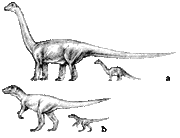
The dwarf megalosaur is a very agile and nimble animal. It usually hunts singly and can prey on the many seabirds that feed in flocks along the tideline. The megalosaur is athletic enough to sprint along the beach and snatch the birds out of the air as they flutter in panic into the sky.
The dwarf megalosaur, Megalosaurus nanus is a megalosaur from the shorelines of the Seychelles that is also a diminutive cousin of the Madagascan megalosaur, from The New Dinosaurs: An Alternative Evolution.
Black and white lari seabirds flock along the tidemark on the silvery sand, pecking at the seaweed and the dead sea animals washed up and left by the ocean. Other more adventurous birds strut about in the dry sand near the fringe of curving palm trees at the head of the beach. They are being watched from the ridge of red granite that sweeps down from the hilly interior of the island and protrudes as a headland at one end of the beach. Suddenly, from the rounded rocks, a sleek green and orange shape darts out onto the dazzling sand and, in a burst and flurry of feathers, one of the more foolhardy birds is caught and killed. The hunter is a tiny megalosaur, similar to that found on the great island of Madagascar 1,000 kilometers (620 miles) to the south. It is only about 3 meters (10 feet) long. It picks up its prey and carries it back to eat in peace in the darkness beneath the palms. As Gondwana ripped itself apart and the landmasses that were to become the Africa and the Indian Subcontinent drifted away from one another, many fragments of continental material were left scattered across the Indian Ocean in between. One particular fragment (Madagascar) is crescent-shaped, about 1,000 kilometers (620 miles) long and is almost totally submerged, but its granite mountain peaks protrude as the scatter of the Seychelle islands about 1,000 kilometers (620 miles) to the northeast of Madagascar. Here again the animals are remnants of the old Gondwana fauna, but they are somewhat different, having evolved to cope with new conditions. On a small island there is not quite so much to eat, and the food is found in a much more limited area. Dwarf forms of animals evolve as the only types that are able to survive the more stringent conditions.

The dwarf species of titanosaurs (a) are only about a fifth of the length of the full-sized Madagascan forms. The dwarf megalosaurs (b) are relatively larger, being about one third of the size of the larger species. The meat-eaters are less restricted in the amount of food available as they also prey on seabirds.
The dwarf megalosaur somewhat has the appearance of one of the lightly built non-avian coelurosaurs, rather than one of the big non-coelurosaurian theropods. It preys on dwarf versions of the plant-eating non-avian dinosaurs (like dwarf titanosaurs), but its light build makes it agile and swift, and it can pursue smaller, fast-moving creatures, such as the seabirds that flock along the white palm-fringed beaches of the islands.
